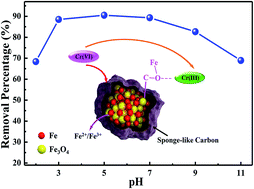Polystyrene controlled growth of zerovalent nanoiron/magnetite on a sponge-like carbon matrix towards effective Cr(vi) removal from polluted water†
Abstract
In situ grown zerovalent nanoiron/magnetite on sponge-like carbon matrix (nZVI/Fe3O4@C) has been evaluated for the removal of toxic hexavalent chromium (Cr(VI)) from polluted water. This material is synthesized by calcination of the epoxide group-functionalized polystyrene (FPS) as the carbon source under a mixture of 5% hydrogen/argon (v/v) atmosphere. The nZVI/Fe3O4@C demonstrates a unique capability to remove Cr(VI) from polluted water over a wide pH range, and the optimal pH value for Cr(VI) removal is 5.0 at 298 K. In comparison, only Fe3O4@C is formed when the as-received PS is used as the carbon source under the same atmosphere conditions and exhibits a poor Cr(VI) removal performance (the removal percentage is around 50% relative to nZVI/Fe3O4@C). Various factors influencing the Cr(VI) removal efficiency, such as treatment time, initial Cr(VI) concentration and nZVI/Fe3O4@C dosage, have been systematically studied. The Cr(VI) removal mechanism is confirmed by X-ray photoelectron spectroscopy (XPS) and Raman tests. The results illustrate that the Cr(VI) is reduced to Cr(III) by nZVI with the simultaneous adsorption of Cr(III) via C–O–Fe bonds on nZVI/Fe3O4@C. The Cr(VI) removal kinetics is determined to follow pseudo-first-order behavior with calculated pseudo-first-order rate constants of 0.01582, 0.02555 and 0.03264 min−1 at 298, 308 and 318 K, respectively, at a pH of 5.0. The low value of the activation energy (28.621 kJ mol−1) indicates that the Cr(VI) reduction process on nZVI/Fe3O4@C is a fast process. The calculated thermodynamic parameters of this chemical reaction, including negative ΔG0, positive ΔH0 and positive ΔS0, suggest that the Cr(VI) reduction on nZVI/Fe3O4@C is spontaneous and endothermic, and more preferred at higher temperatures. Both the kinetics and thermodynamics show that the nZVI/Fe3O4@C is a promising material for highly fast and efficient removal of Cr(VI) from polluted water.



 Please wait while we load your content...
Please wait while we load your content...